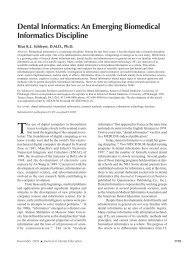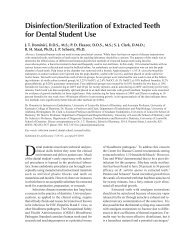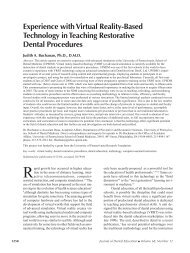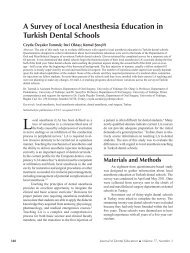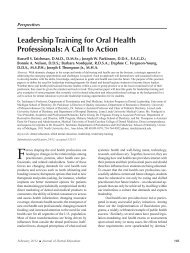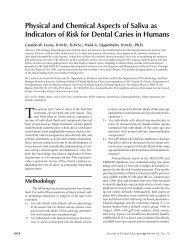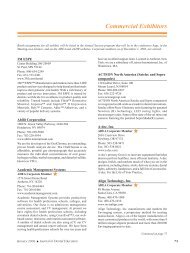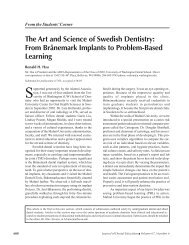List of Poster Presentations - Journal of Dental Education
List of Poster Presentations - Journal of Dental Education
List of Poster Presentations - Journal of Dental Education
Create successful ePaper yourself
Turn your PDF publications into a flip-book with our unique Google optimized e-Paper software.
<strong>Poster</strong> Abstracts<br />
The purpose <strong>of</strong> this project is to determine the prevalence <strong>of</strong><br />
learning disabilities in dental education.<br />
The prevalence <strong>of</strong> learning disabilities in higher education has<br />
drawn significant attention at the undergraduate level. College<br />
freshman reporting learning disabilities have increased significantly<br />
in the past 20 years; in 1978, 0.6 percent <strong>of</strong> all freshman reported<br />
having a learning disability compared with 3.7 percent in 1998.<br />
Moreover, 53% <strong>of</strong> college freshman with learning disabilities plan to<br />
seek Master or Doctoral level degrees. Anecdotal evidence suggests<br />
an increase in the number <strong>of</strong> dental students with learning disabilities,<br />
but nothing has been published regarding how dental education is<br />
effected by this generalized trend. The purpose <strong>of</strong> this study, therefore,<br />
is to obtain information from appropriate U.S. dental school<br />
administrators regarding the prevalence <strong>of</strong> dental students with<br />
learning disabilities. A pilot study, designed to identify individuals<br />
responsible for working with students with learning disabilities in<br />
U.S. dental schools (response rate 90.3%, n=52), revealed that 98.1%<br />
<strong>of</strong> schools have an in-house contact (51.0% Student Affairs, 43.3%<br />
Academic Affairs, 3.8% Academic and Student Affairs, 1.9%<br />
Admissions). A more specific survey has been developed and is being<br />
distributed to specific contact individuals at US dental schools. It is<br />
hypothesized that the trends occurring in undergraduate colleges will<br />
be observed in dental schools as well.<br />
This issue is being dealt with in a variety <strong>of</strong> different<br />
administrative settings within dental schools. As a follow-up, a more<br />
detailed survey is being sent to all U.S. dental schools.<br />
14. After the Screening: Providing Treatment Targeted<br />
to Pre- and Elementary School Children with the<br />
Highest Unmet Oral Health Care Needs<br />
DeCastro, Jeanette, University <strong>of</strong> Medicine and Dentistry <strong>of</strong> New<br />
Jersey - New Jersey <strong>Dental</strong> School, Bolger, David, University <strong>of</strong><br />
Medicine and Dentistry <strong>of</strong> New Jersey - New Jersey <strong>Dental</strong> School,<br />
Noel, Kenson, University <strong>of</strong> Medicine and Dentistry <strong>of</strong> New Jersey -<br />
New Jersey <strong>Dental</strong> School, Dennis, Yede B., University <strong>of</strong> Medicine<br />
and Dentistry <strong>of</strong> New Jersey - New Jersey <strong>Dental</strong> School, Panagakos,<br />
Fotinos S., University <strong>of</strong> Medicine and Dentistry <strong>of</strong> New Jersey - New<br />
Jersey <strong>Dental</strong> School<br />
Purpose: To describe a program that provides follow-up<br />
treatment, oral health instruction and referrals for children who were<br />
identified as needing care but who did not receive care.<br />
The recent Report on Oral Health from the U.S. Surgeon<br />
General’s Office pointed out higher disease levels in the oral health<br />
<strong>of</strong> diverse populations. The New Jersey <strong>Dental</strong> School (NJDS) meets<br />
its goals <strong>of</strong> improving the oral health <strong>of</strong> the most vulnerable people<br />
in underserved communities through large-scale screenings and<br />
delivering oral health services. Recently, a team <strong>of</strong> students, dental<br />
assistants and supervising faculty screened over 1,300 pre-, elementary<br />
and middle-school children in depressed urban and rural areas <strong>of</strong><br />
Camden and Atlantic counties. Results indicated visible signs <strong>of</strong> dental<br />
decay in 39 to 63 percent <strong>of</strong> those children screened, depending on<br />
the screening site. During the second year <strong>of</strong> this project, pre-school<br />
programs and schools with the highest levels <strong>of</strong> decay (all in Atlantic<br />
County) were targeted for pilot follow-up programs. These programs<br />
implemented by NJDS students and faculty included a program to<br />
provide sealants and oral health instruction to elementary school<br />
children, and a program to provide oral health education and necessary<br />
treatment or referrals for pre-school children identified as needing<br />
care who had not yet obtained follow-up treatment one year after the<br />
initial screenings.<br />
Implementation <strong>of</strong> post-screening projects are necessary for<br />
accurate evaluation <strong>of</strong> oral health improvement in the population<br />
served, will contribute to increased oral health in the targeted<br />
populations, and can identify resources for local access to care.<br />
15. Establishing a Combination Honor System/Proctor<br />
System to Promote Academic Integrity<br />
Deem, Lisa P., Temple University School <strong>of</strong> Dentistry, Stark, Alan M.,<br />
Temple University School <strong>of</strong> Dentistry<br />
Purpose: To describe a successful honor/disciplinary system in<br />
place at a large dental school for four years.<br />
In 1997 Temple University School <strong>of</strong> Dentistry combined the<br />
traditional proctor system <strong>of</strong> institutional policing <strong>of</strong> students’ behavior<br />
with an Honor System that requires the students to regulate their own<br />
behavior. The objective <strong>of</strong> the integration <strong>of</strong> the two disciplinary<br />
approaches was to utilize the strengths <strong>of</strong> each system to ensure<br />
pr<strong>of</strong>essional integrity. The proctor system allows for experienced<br />
administrators to enforce the rules within the boundaries <strong>of</strong><br />
confidentiality and due process, while the honor code system places<br />
the responsibility <strong>of</strong> integrity within the group <strong>of</strong> adult students. Prior<br />
to 1997, each system was in use individually for different periods.<br />
The Disciplinary Committee (proctor system) failed to include the<br />
students as a whole in the pursuit <strong>of</strong> pr<strong>of</strong>essional integrity. The studentcontrolled<br />
honor system fell short in procedural and substantive due<br />
process. The newly established Honor Code enforced by the Honor<br />
Board, comprised <strong>of</strong> students and faculty, was developed in<br />
cooperation with University Counsel. The students are provided with<br />
written notice <strong>of</strong> specific behaviors that constitute Honor Code<br />
violations. Prior to matriculation they sign a form indicating that they<br />
received notification. Notice is provided verbally at first year<br />
orientation and at clinic orientation. Dispositions <strong>of</strong> Honor Board<br />
hearings are published, quarterly, protecting the identity <strong>of</strong> the parties<br />
In the first three years that the new system was in effect, three fullyear<br />
suspensions were imposed for academic cheating and one<br />
expulsion for clinical forgery. In the past year, there have been no<br />
reported violations. An integrated proctor/honor system is more<br />
effective in establishing and enforcing pr<strong>of</strong>essional integrity than<br />
either system standing alone.<br />
An Honor Code system enforced by faculty and students is<br />
effective in promoting academic integrity.<br />
16. A Student Organized Program in the Dominican<br />
Republic<br />
Dhaliwal, Sukhdeep S., Case Western Reverve University School <strong>of</strong><br />
Dentistry, Colic, Allen D., Case Western Reserve University School<br />
<strong>of</strong> Dentistry, Lalumandier, James, Case Western Reserve University<br />
School <strong>of</strong> Dentistry, Jasinevicius, Roma T., Case Western Reserve<br />
University School <strong>of</strong> Dentistry,<br />
Humanitarian exercises for dental students can be an<br />
enlightening and valuable educational experience. In 1999 a group<br />
<strong>of</strong> CWRU students worked with a physician to establish a dental &<br />
medical clinic in an impoverished rural area <strong>of</strong> the Dominican<br />
Republic (DR). The goal was to establish a facility, which would<br />
provide comprehensive dental care. In 2000, two students and a faculty<br />
member made a preliminary trip to the DR to gather patient<br />
demographic data and to provide emergency care. A temporary clinic<br />
was set up. Upon returning the students initiated the DR Elective<br />
Program (DREP). The educational objectives <strong>of</strong> the program are<br />
congruent with dentistry’s pr<strong>of</strong>essional oath “to serve humanity,<br />
patients, community, and the pr<strong>of</strong>ession.” Through the program<br />
students have the opportunity to experience 3rd world dentistry, from<br />
which they gain knowledge about international humanitarian relief<br />
as well as improve their skills. The DREP is unique in that it is student<br />
initiated and student run. Students even pay their own way. To date<br />
there have been 4 one-week visits, in which students (n=65) provided<br />
dental care to over 1000 patients (age range 4-70 years).<br />
Accompanying the students are 1 or 2 faculty members, 1 private<br />
dentist, and sometimes other volunteers. The clinic procedures include<br />
262 <strong>Journal</strong> <strong>of</strong> <strong>Dental</strong> <strong>Education</strong> ■ Volume 66, No. 2



